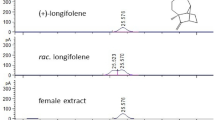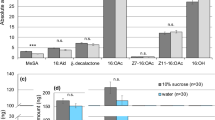Abstract
SEXUAL recognition and attraction in many insects have been shown to involve chemical communicants called pheromones1, and these results are widely applied in agriculture2. In contrast very little is known about (sex) pheromones in crustaceans, the only experimental verification being that of Ryan3 who observed that males of the Pacific crab, Portunus sanguinolentus, displayed towards water from premoult females. No response was obtained after the excretory pores of the females had been sealed. A few other publications on crustacean behaviour and natural history suggest such a chemical communication system. Berry4 observed in Panulirus homarus that “male lobsters show sudden attraction to particular sexually mature females” and speculated that the tegumentary glands may be involved. Hughes and Matthiessen5 stated that “it appears as if the freshly moulted female (Homarus americanus) exerts a chemical attraction on the male”. Some other indications for the existence of a sex pheromonecan be found6 without experimental evidence, however. This lack of experimental evidence, even in reports on crustacean mating behaviour7, is remarkable considering the economic importance of such Crustacea as lobsters and shrimp and the benefits for culturing these animals, if a sex pheromone were known and available.
This is a preview of subscription content, access via your institution
Access options
Subscribe to this journal
Receive 51 print issues and online access
$199.00 per year
only $3.90 per issue
Buy this article
- Purchase on Springer Link
- Instant access to full article PDF
Prices may be subject to local taxes which are calculated during checkout
Similar content being viewed by others
References
Schneider, D., Science, 163, 1031 (1969); Wilson, E. O., Science, 149, 1064 (1965).
Biological Control of Insect Pests and Weeds (edit. by DeBach, P. H.,) (Reinhold, New York, 1964).
Ryan, E. P., Science, 151, 340 (1966).
Berry, P. F., S. African Assoc. Mar. Biol. Res., Oceanog. Res. Inst. Invest. Rep. No. 24 (1970).
Hughes, J. T., and Matthiessen, G. C., Limn. Oceanog., 7, 414 (1962).
Burkenroad, M. D., Amer. Naturalist, 81, 392 (1947).
Snow, I. D., and Neilsen, J. R., J. Fish. Res. Board Canad., 23, 1319 (1966); Templeman, W., Contrib. Canad. Biol. Fish., 8, 423 (1934).
Carlisle, D. B., and Knowles, F., Endocrine Control in Crustaceans (Cambridge University Press, London, 1959); Panouse, J. B., Ann. Inst. Océanog. Monaco, 23, 65 (1946); Panouse, J. B., CR Acad. Sci., 217, 553 (1943).
Atema, J., thesis, Univ. Michigan, Ann Arbor (1969); Atema, J., et al., in Olfaction and Taste III (edit. by Pfaffmann, C.) (Rockefeller University Press, New York, 1969); Todd, J. H., thesis, Univ. Michigan, Ann Arbor (1968).
Author information
Authors and Affiliations
Rights and permissions
About this article
Cite this article
ATEMA, J., ENGSTROM, D. Sex Pheromone in the Lobster, Homarus americanus. Nature 232, 261–263 (1971). https://doi.org/10.1038/232261a0
Received:
Revised:
Issue Date:
DOI: https://doi.org/10.1038/232261a0
This article is cited by
-
Primer and Short-Range Releaser Pheromone Properties of Premolt Female Urine from the Shore Crab Carcinus maenas
Journal of Chemical Ecology (2005)
-
Indirect evidence indicates female semiochemicals release male precopulatory behaviour in the snow crab,Chionoecetes opilio (Brachyura: Majidae)
Chemoecology (1996)
-
A critical body size for use of pheromones in mate location
Journal of Chemical Ecology (1995)
-
Precopulatory guarding-time of the male amphipod Eogammarus oclairi: effect of population structure
Marine Biology (1995)
-
Mate competition in the velvet swimming crab Necora puber: effects of perceived resource value on male agonistic behaviour
Marine Biology (1994)
Comments
By submitting a comment you agree to abide by our Terms and Community Guidelines. If you find something abusive or that does not comply with our terms or guidelines please flag it as inappropriate.



